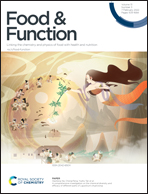Ginger: a systematic review of clinical trials and recent advances in encapsulation of its bioactive compounds
Abstract
Recently, the numbers of studies on natural products have considerably increased owing to their exceptional biological activities and health benefits. Their pharmacological attributes have played an immense role in detecting natural and safe alternative therapeutics, consequently extending their industrial applications. In this line, ginger (Zingiber officinale) has been gaining wide attention owing to its bioactive compounds, such as phenolic and terpene compounds. Ginger has a great pharmacological and biological potential in the prevention and treatment of various diseases, namely colds, nausea, arthritis, migraines and hypertension. However, these bioactive compounds are unstable and susceptible to degradation, volatilization and oxidation during extraction and processing, mainly owing to their exposure to environments with adverse conditions, such as high temperature, the presence of O2 and light. In this sense, this current review covers a wide range of topics, starting from the chemical profile and biological properties of ginger bioactive compounds (GBCs), their clinical effectiveness for the treatment of diseases and the application of different encapsulation methods (molecular inclusion, spray drying, complex coacervation, ionic strength and nanoemulsions) to protect and improve their application in food products. This work summarizes the fundamental principles of, recent progress in and effectiveness of different methods regarding the physicochemical, structural and functional properties of encapsulated GBCs. The potential use of encapsulated GBCs as a promising active ingredient to be applied in different food products is discussed in detail.



 Please wait while we load your content...
Please wait while we load your content...